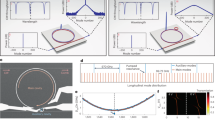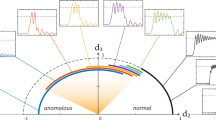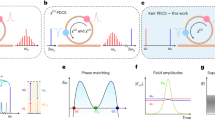Abstract
Thermal noise is ubiquitous in microscopic systems and high-precision measurements. The control of thermal noise would reveal quantum regimes1 and enable fundamental physics searches2. Recently, nonlinearity in microresonators has enabled laser devices such as Kerr microresonator soliton frequency combs3. Soliton microcombs explore nonlinear dynamics and enable optical synthesizers4, optical clockwork5 and data communications systems6. Here, we explore how thermal noise leads to the fundamental decoherence of microcombs. We show that a particle-like soliton, which is an ensemble of comb modes, is closely coupled to the thermal fluctuations of its silicon-chip-based resonator. The microcomb modal linewidth is thus thermally broadened, and we characterize these thermal-noise correlations through a soliton effective temperature. Moreover, we demonstrate that passive laser cooling reduces soliton thermal decoherence to far below the ambient-temperature limit. We implement laser cooling by photothermal forcing, and we observe cooling of the frequency comb modes to 84 K. Our work illuminates inherent connections between nonlinear photonics and microscopic fluctuations.
This is a preview of subscription content, access via your institution
Access options
Access Nature and 54 other Nature Portfolio journals
Get Nature+, our best-value online-access subscription
$29.99 / 30 days
cancel any time
Subscribe to this journal
Receive 12 print issues and online access
$209.00 per year
only $17.42 per issue
Buy this article
- Purchase on Springer Link
- Instant access to full article PDF
Prices may be subject to local taxes which are calculated during checkout




Similar content being viewed by others
Data availability
The data that support the plots within this paper and other findings of this study are available from the corresponding author upon reasonable request.
References
Anderson, M. H., Ensher, J. R., Matthews, M. R., Wieman, C. E. & Cornell, E. A. Observation of Bose–Einstein condensation in a dilute atomic vapor. Science 269, 198–201 (1995).
Parker, R. H., Yu, C., Zhong, W., Estey, B. & Müller, H. Measurement of the fine-structure constant as a test of the standard model. Science 360, 191–195 (2018).
Kippenberg, T. J., Gaeta, A. L., Lipson, M. & Gorodetsky, M. L. Dissipative Kerr solitons in optical microresonators. Science 361, eaan8083 (2018).
Spencer, D. T. et al. An optical-frequency synthesizer using integrated photonics. Nature 557, 81–85 (2018).
Drake, T. E. et al. Terahertz-rate, Kerr-microresonator optical clockwork. Phys. Rev. X 9, 031023 (2019).
Marin-Palomo, P. et al. Microresonator solitons for massively parallel coherent optical communications. Nature 546, 274–279 (2017).
Landau, L. D., Lifshitz, E. M. & Pitaevskii, L. in Statistical Physics Part I 333–364 (Pergamon Press, 1980).
Numata, K., Kemery, A. & Camp, J. Thermal-noise limit in the frequency stabilization of lasers with rigid cavities. Phys. Rev. Lett. 93, 250602 (2004).
Liu, Y. T. & Thorne, K. S. Thermoelastic noise and homogeneous thermal noise in finite sized gravitational-wave test masses. Phys. Rev. D 62, 122002 (2000).
Abbott, B. P. et al. Observation of gravitational waves from a binary black hole merger. Phys. Rev. Lett. 116, 061102 (2016).
Ludlow, A. D., Boyd, M. M., Ye, J., Peik, E. & Schmidt, P. O. Optical atomic clocks. Rev. Mod. Phys. 87, 637–701 (2015).
Phillips, W. D. Nobel lecture: Laser cooling and trapping of neutral atoms. Rev. Mod. Phys. 70, 721–741 (1998).
Aspelmeyer, M., Kippenberg, T. J. & Marquardt, F. Cavity optomechanics. Rev. Mod. Phys. 86, 1391–1452 (2014).
Metzger, C. H. & Karrai, K. Cavity cooling of a microlever. Nature 432, 1002–1005 (2004).
Gigan, S. et al. Self-cooling of a micromirror by radiation pressure. Nature 444, 67–70 (2006).
Seletskiy, D. V. et al. Laser cooling of solids to cryogenic temperatures. Nat. Photon. 4, 161–164 (2010).
Moss, D. J., Morandotti, R., Gaeta, A. L. & Lipson, M. New CMOS-compatible platforms based on silicon nitride and Hydex for nonlinear optics. Nat. Photon. 7, 597–607 (2013).
Matsko, A. B., Savchenkov, A. A., Yu, N. & Maleki, L. Whispering-gallery-mode resonators as frequency references. I. Fundamental limitations. J. Opt. Soc. Am. B 24, 1324–1335 (2007).
Li, X. et al. Universal isocontours for dissipative Kerr solitons. Opt. Lett. 43, 2567–2570 (2018).
Bao, C. et al. Observation of Fermi-Pasta-Ulam recurrence induced by breather solitons in an optical microresonator. Phys. Rev. Lett. 117, 163901 (2016).
Cole, D. C., Lamb, E. S., Del’Haye, P., Diddams, S. A. & Papp, S. B. Soliton crystals in Kerr resonators. Nat. Photon. 11, 671–676 (2017).
Jones, D. J. et al. Carrier-envelope phase control of femtosecond mode-locked lasers and direct optical frequency synthesis. Science 288, 635–639 (2000).
Gorodetsky, M. L. & Grudinin, I. S. Fundamental thermal fluctuations in microspheres. J. Opt. Soc. Am. B 21, 697–705 (2004).
Sun, X., Luo, R., Zhang, X.-C. & Lin, Q. Squeezing the fundamental temperature fluctuations of a high-Q microresonator. Phys. Rev. A 95, 023822 (2017).
Yi, X. et al. Single-mode dispersive waves and soliton microcomb dynamics. Nat. Commun. 8, 14869 (2017).
Huang, G. et al. Thermorefractive noise in silicon-nitride microresonators. Phys. Rev. A 99, 061801 (2019).
Grudinin, I., Lee, H., Chen, T. & Vahala, K. Compensation of thermal nonlinearity effect in optical resonators. Opt. Express 19, 7365–7372 (2011).
Zhang, S. et al. Sub-milliwatt-level microresonator solitons with extended access range using an auxiliary laser. Optica 6, 206–212 (2019).
Restrepo, J., Gabelli, J., Ciuti, C. & Favero, I. Classical and quantum theory of photothermal cavity cooling of a mechanical oscillator. C. R. Phys. 12, 860–870 (2011).
Briles, T. C. et al. Interlocking kerr-microresonator frequency combs for microwave to optical synthesis. Opt. Lett. 43, 2933–2936 (2018).
Stone, J. R. et al. Thermal and nonlinear dissipative-soliton dynamics in Kerr-microresonator frequency combs. Phys. Rev. Lett. 121, 063902 (2018).
Li, Z. et al. Thulium-doped fiber amplifier for optical communications at 2 μm.Opt. Express 21, 9289–9297 (2013).
Lamb, E. S. et al. Optical-frequency measurements with a Kerr microcomb and photonic-chip supercontinuum. Phys. Rev. Appl. 9, 024030 (2018).
Jost, J. D. et al. Counting the cycles of light using a self-referenced optical microresonator. Optica 2, 706–711 (2015).
Brasch, V., Lucas, E., Jost, J. D., Geiselmann, M. & Kippenberg, T. J. Self-referenced photonic chip soliton Kerr frequency comb. Light Sci. Appl. 6, e16202 (2017).
DiDomenico, G., Schilt, S. & Thomann, P. Simple approach to the relation between laser frequency noise and laser line shape. Appl. Opt. 49, 4801–4807 (2010).
Huszank, R., Csedreki, L., Kertész, Z. & Török, Z. Determination of the density of silicon-nitride thin films by ion-beam analytical techniques (RBS, PIXE, STIM). J. Radioanalyt. Nucl. Chem. 307, 341–346 (2016).
Bai, S., Tang, Z., Huang, Z. & Yu, J. Thermal characterization of Si3N4 thin films using transient thermoreflectance technique. IEEE Trans. Ind. Electr. 56, 3238–3243 (2009).
Li, Q. et al. Stably accessing octave-spanning microresonator frequency combs in the soliton regime. Optica 4, 193–203 (2017).
Xue, X. et al. Thermal tuning of Kerr frequency combs in silicon nitride microring resonators. Opt. Express 24, 687–698 (2016).
Sinclair, L. C. et al. A compact optically coherent fiber frequency comb. Rev. Sci. Instrum. 86, 081301 (2015).
Kippenberg, T. J., Schliesser, A. & Gorodetsky, M. Phase noise measurement of external cavity diode lasers and implications for optomechanical sideband cooling of ghz mechanical modes. N. J. Phys. 15, 015019 (2013).
Acknowledgements
We thank K. Srinivasan for fabricating the SiN microresonators, S.-P. Yu for creating the mode simulation in Fig. 1, D. Spencer for experimental assistance, and Srico, Inc. for the use of the periodically poled lithium-niobate waveguide device. This research is supported by the Defense Advanced Research Projects Agency DODOS programme, AFOSR (FA9550-16-1-0016), NRC and NIST.
Author information
Authors and Affiliations
Contributions
T.E.D. and J.R.S. performed the experiments and analysed the data. T.C.B. assisted in all aspects of the work. S.B.P. contributed to all aspects of the work and supervised the project.
Corresponding author
Ethics declarations
Competing interests
The authors declare no competing interests.
Additional information
Publisher’s note Springer Nature remains neutral with regard to jurisdictional claims in published maps and institutional affiliations.
Supplementary information
Supplementary Information
Supplementary Figs. 1 and 2, and discussion.
Rights and permissions
About this article
Cite this article
Drake, T.E., Stone, J.R., Briles, T.C. et al. Thermal decoherence and laser cooling of Kerr microresonator solitons. Nat. Photonics 14, 480–485 (2020). https://doi.org/10.1038/s41566-020-0651-8
Received:
Accepted:
Published:
Issue Date:
DOI: https://doi.org/10.1038/s41566-020-0651-8
This article is cited by
-
All-optical frequency division on-chip using a single laser
Nature (2024)
-
Versatile tuning of Kerr soliton microcombs in crystalline microresonators
Communications Physics (2023)
-
Recent advances in laser self-injection locking to high-Q microresonators
Frontiers of Physics (2023)
-
Coherent terahertz radiation with 2.8-octave tunability through chip-scale photomixed microresonator optical parametric oscillation
Nature Communications (2022)
-
Coherent optical communications using coherence-cloned Kerr soliton microcombs
Nature Communications (2022)



